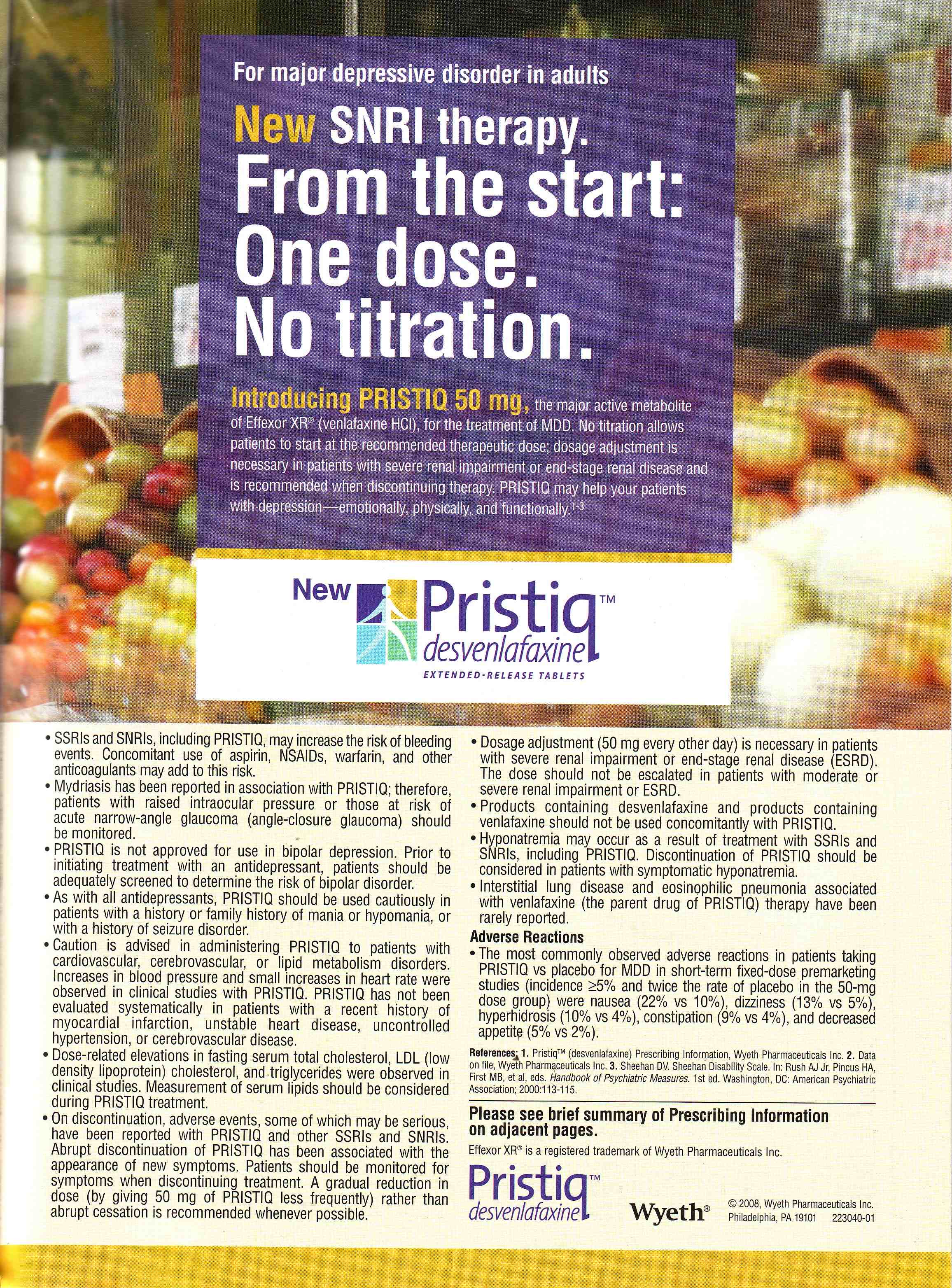Healthy Skepticism AdWatch
AdWatch illuminates the logical, psychological and pharmacological techniques used in drug advertisements.
April 2010, USA
Wyeth’s Pristiq® (desvenlafaxine) for major depressive disorder
This advertisement misleadingly promotes a serotonin and noradrenalin reuptake inhibitor (SNRI) antidepressant on the basis of not needing titration. The antidepressant is a metabolite of an established SNRI, which is approaching the end of its patent life in several countries. No evidence is provided of its effectiveness and safety relative to the established drug.
This advertisement appeared in the August 20, 2008 issue of Journal of the American Medical Association and elsewhere.


It promotes a serotonin and noradrenalin reuptake inhibitor (SNRI) antidepressant on the basis of not needing titration. The antidepressant is a metabolite of an established SNRI, which is approaching the end of its patent life in several countries. No evidence is provided of its effectiveness and safety relative to the established drug.
Brand name
Possible connotations of Pristiq include ‘prestige’ and ‘mystique’. That may appeal to people with aspirations for higher status, in which case it would be misleading. Another connotation is ‘pristine’, suggesting perfection.
Logo
The logo for the drug may be interpreted as a person striding away from dark/blue/night-time colours into happier daylight colours. That could be interpreted as implying that the drug is as effective as day follows night, i.e. invariably effective as a treatment for depression, in which case it would be misleading.
Headline
“New SNRI therapy.
From the start:
One dose.
No titration.”
The word ‘new’, which is also in a banner across one corner of the main photograph, triggers the ‘newer is better’ heuristic. This is misleading because Wyeth does not provide any evidence to show that Pristiq is equal to, let alone better than, other treatments for depression on the most important parameters: efficacy and adverse effects. The only possible advantage mentioned is the claim that titration from the starting dose to the maintenance dose is not needed. However, dose adjustment is usually not needed for many other antidepressant drugs, so this is an advantage only compared with a subset of antidepressants. Even with those drugs, because the advantage is minor, Pristiq may be inferior overall if it is not as good in terms of efficacy.
The claim ‘From the start: One dose. No titration.’ is false in almost all cases. The claim is contradicted in the copy (in fine print) which states that: ‘dose adjustment is necessary in patients with severe renal impairment or end-stage renal disease and is recommended when discontinuing therapy’. Severe renal disease is not common, but titration is recommended for everyone except those who continue the drug until they die. Many people prescribed antidepressants discontinue use within months. Australia’s National Prescribing Service recommends taking Pristiq on alternate days during discontinuation to avoid symptoms such as anxiety and agitation. Therefore the claim that titration is not required will be misleading for the many people who read the headline but not the fine print. In addition, higher doses of antidepressants are associated with increased risk of adverse effects, and lower doses can provide similar efficacy. Furthermore, adverse effects of antidepressants can overlap with symptoms of depression, and can be inadvertently perpetuated by increased doses if they are attributed to depression.
Picture
The main photograph shows a middle-aged man and an attractive younger woman smiling at each other while shopping together or perhaps encountering each other while shopping separately. The woman has very white perfect-looking teeth, suggesting health and wealth. The second photograph shows a close-up of wholesome-looking fruit and vegetables, reinforcing the impression of wellbeing. The meaning of the main picture is ambiguous, but it is likely to be interpreted by many people as an ‘after picture’ showing successful treatment of major depressive disorder. Wishful thinking (with or without awareness) in response to this ambiguity may lead to interpreting the picture as indicating 100% success rates for treatment of major depressive disorder, and beneficial effects on relationships. Thus the picture may mislead via a combination of ambiguity and wishful thinking.
Copy
Wyeth deserves praise for stating in large type the approved indication, ‘major depressive disorder in adults’, rather than using the wider term ‘depression’. However, as is mentioned in the boxed warning, there is evidence that antidepressants may increase suicidality in young people. This risk possibly extends up to the age of 24. To our knowledge there is no convincing evidence to support using any antidepressant for young people.
The remainder of the copy is in fine print. What the copy claims about titration was discussed in the Headline section.
The copy states: ‘PRISTIQ may help your patients with depression – emotionally, physically, and functionally’. This claim has three references, which are discussed below. This claim widens the indication to depression more generally rather than just major depressive disorder. The terms ‘emotionally, physically, and functionally’ are very broad, so they are open to many interpretations, some of which may be misleading. It is unclear what ‘physically’ means in this context. The statement may be true but unhelpful because it does not provide the comparative information required for choosing between other drug and non-drug treatments, or no treatment, for major depressive disorder.
References
1. Product information (which contains no information about comparisons except versus placebo).
2. Data on file. This suggests that relevant information has not been published.
3. A review of the Sheehan Disability Scale in a textbook published in 2000. This review does not mention Pristiq. Its use as a reference for this point is misleading, suggesting that it provides evidence of Pristiq’s effectiveness. This book would not be readily available to most primary care practitioners, who prescribe the majority of antidepressants, so it would be hard for them to check what it says.
Fine print
There is fine print in a readable type size filling about 40% of the first 2 pages, then 1.5 pages of very fine print. Evaluation of the details of the fine print is beyond the scope of this AdWatch.
What’s missing?
Desvenlafaxine is a metabolite of venlafaxine. The advertisement refers to it as ‘the major active metabolite of Effexor® (venlafaxine HCl)’, but does not provide any information about their relative advantages and disadvantages. The development and marketing of drugs that are slightly different chemically from established drugs is a common ‘evergreening’ strategy used by pharmaceutical companies to extend patent life, often without significant advantages. Many drugs are a mixture of both left-and right-handed molecules that are mirror images of each other (enantiomers). Pharmaceutical companies are increasingly marketing single-enantiomer versions of their existing drugs that are mixtures of the two enantiomers (racemates). This is referred to as ‘chiral switching’.
A similar approach is to identify the active metabolite of an existing product, and develop that metabolite as a drug in its own right. Sometimes there is a good reason for doing this, such as in the case of the antihistamine, terfenadine, which caused significant adverse effects that its metabolite, fexofenadine, did not. In that case, there was a safety advantage when fexofenadine was developed as a new drug. However, according to Australia’s National Prescribing Service, in the case of desvenlafaxine there is ‘no evidence that desvenlafaxine is more effective, safer or better tolerated than venlafaxine or other antidepressants’.
Furthermore, although desvenlafaxine was approved in the United States and in Australia, Wyeth withdrew its application in Europe because the European Medicines Agency (EMEA) was critical of the evidence, particularly the dosages used and the lack of statistically significant results in several trials. The EMEA also questioned the clinical relevance of the results, and was concerned that very few elderly people were included in the trials.
The headline, picture and copy do not provide any information about adverse effects, warnings etc. It is not possible to make a good decision regarding use of this drug without reading the smaller print, which most people do not do. In addition, the advertisement does not provide any information about cost.
Overall
A superficial reading will mislead many people to the impression that the drug is an appropriate choice for major depressive disorder and perhaps wider indications. However, the advertisement does not provide any valid reasons for using this drug. As far as we are aware, there are no valid reasons for using this drug rather than other treatments when indicated. Since most health professionals are unlikely to give advertisements more than a superficial inspection, they are likely to be misled by this one.
IFPMA Code breaches
This advertisement breaches section 4.2 of IFPMA Code in several ways including:
• It contains statements that are not accurate: ‘From the start: One dose. No titration.’
• The sections of the advertisement that are most likely to be read are not balanced: The headline, picture and copy do not provide any information about adverse effects, warnings, prices etc.
• The advertisement is not sufficiently complete to enable the recipient to form his or her own opinion of the therapeutic value of the pharmaceutical product concerned: it does not provide any comparative information regarding efficacy, adverse effects or prices.
• The advertisement is not based on an up-to-date evaluation of all relevant evidence and does not reflect that evidence clearly: it does not provide any comparative information regarding efficacy or adverse effects.
• The advertisement is misleading in several ways mentioned above, including misleading via omission.
• The advertisement contains an all-embracing claim without adequate qualification and substantiation: ‘From the start: One dose. No titration.’
• This advertisement breaches the required of section 5.1 of the IFPMA code that the date of production of the advertisement be stated, by only stating the year of copyright rather than the month and year of production.
Indexes:
AdWatch (USA)
Page views since 15 March 2010: 24497
Comments
Our members can see and make comments on this page.


